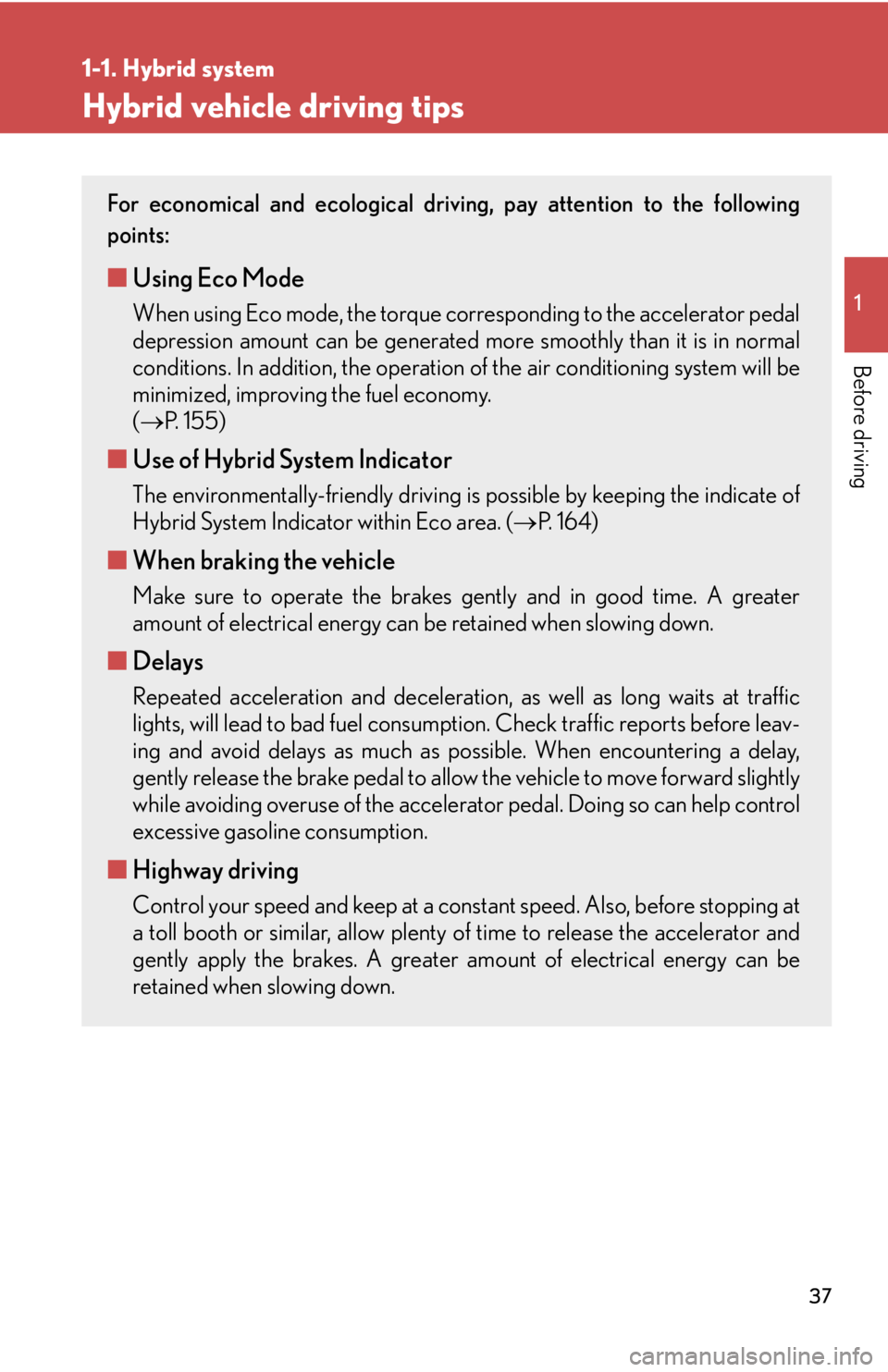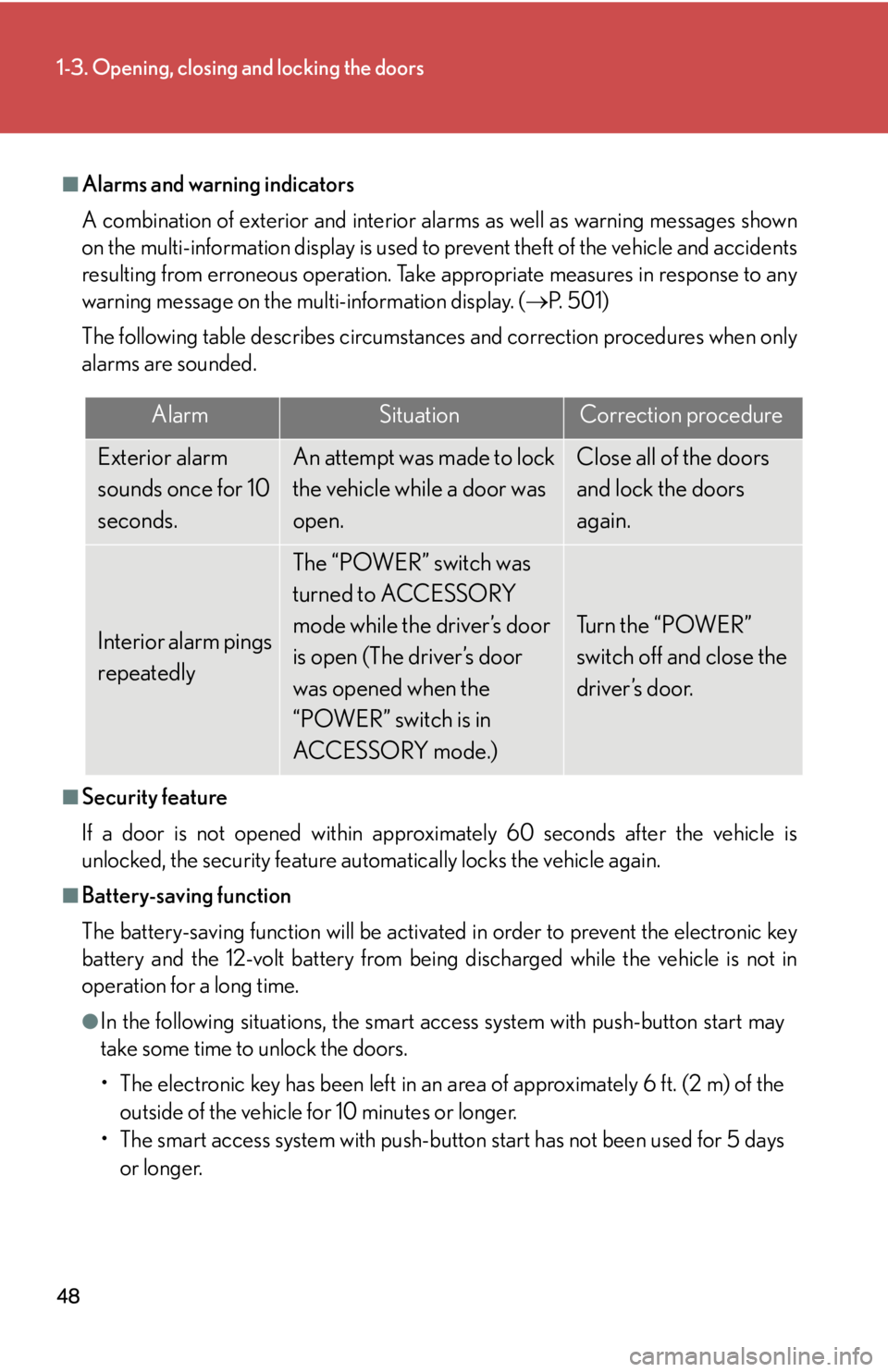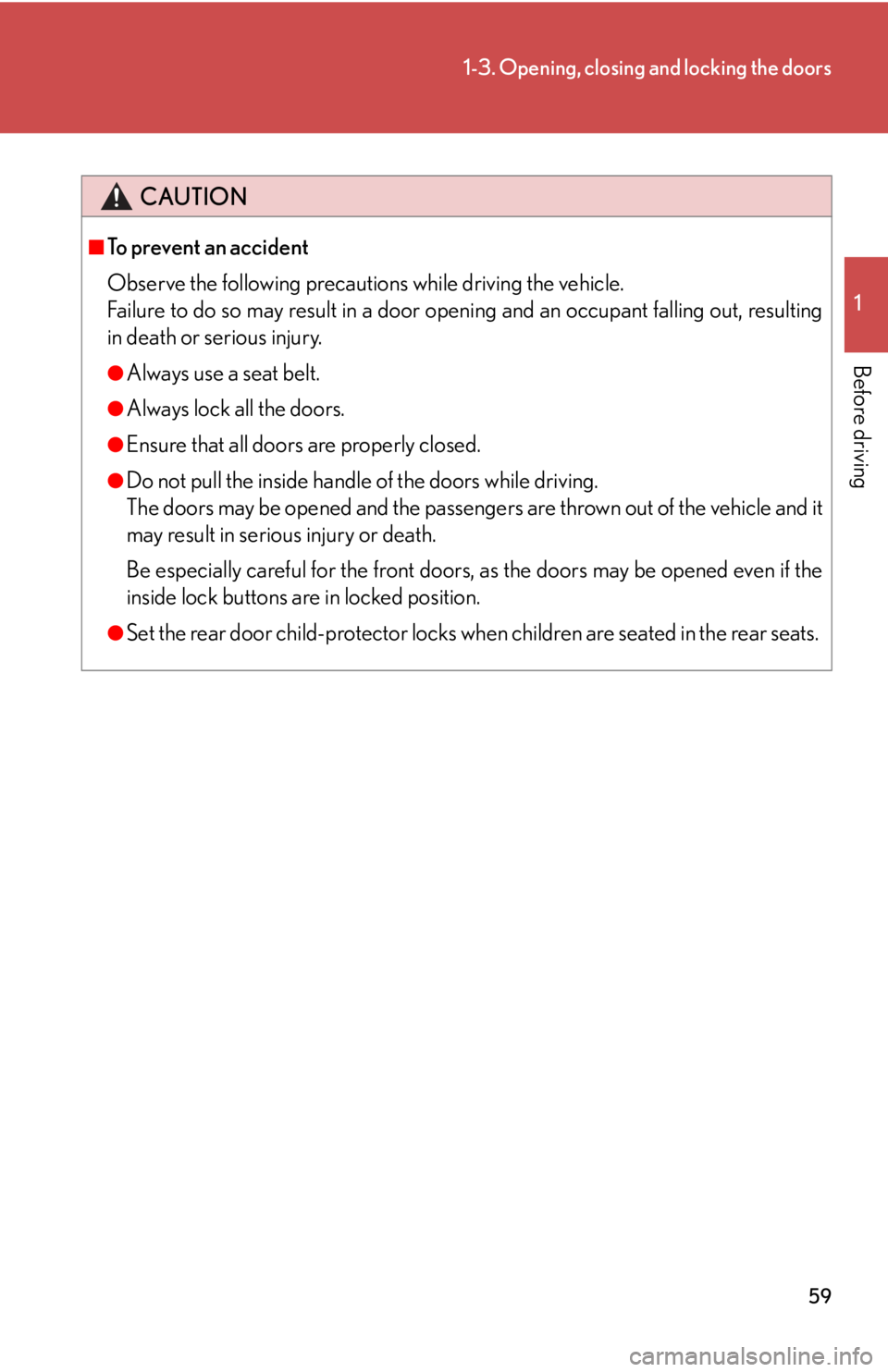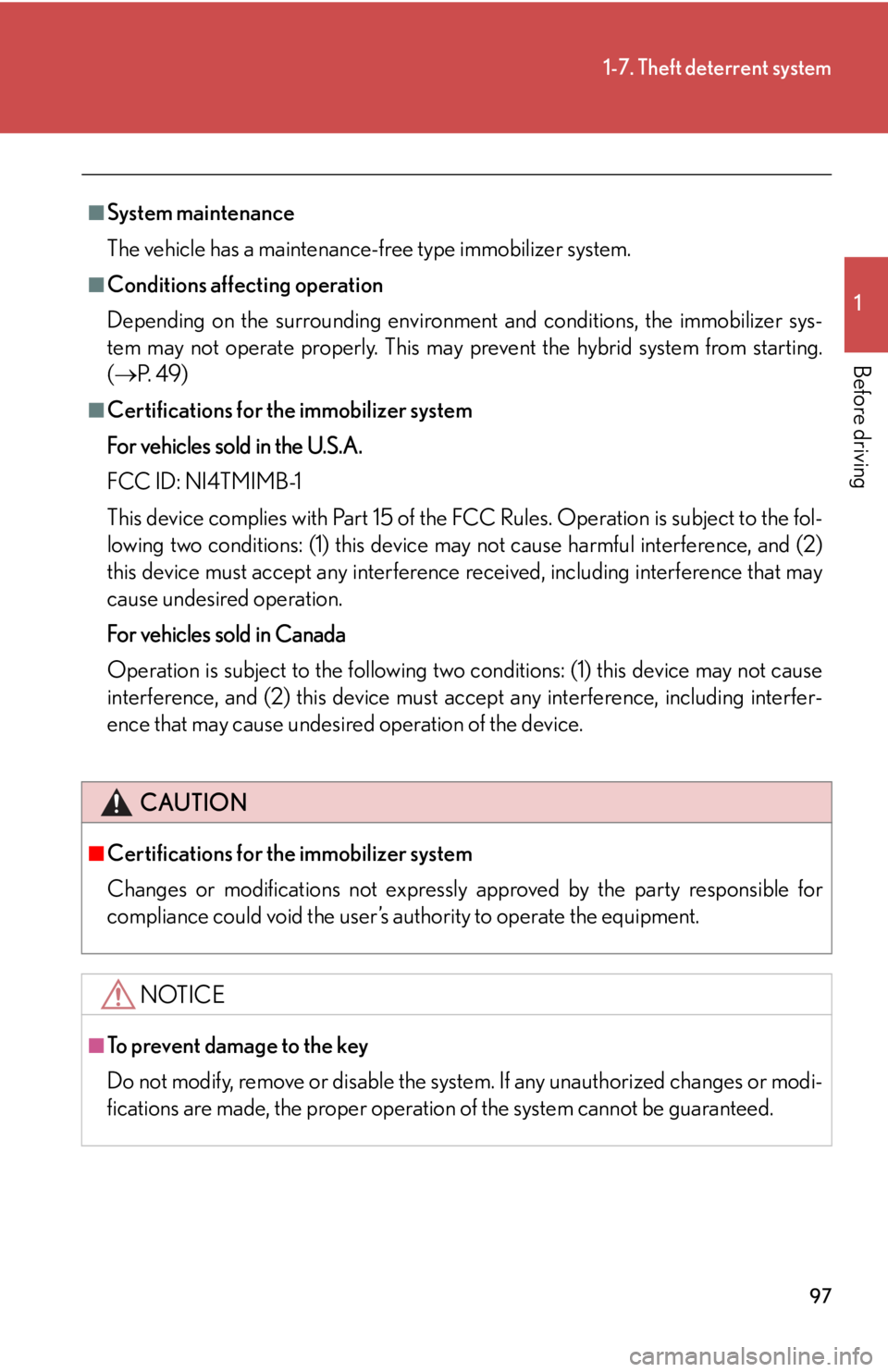ESP Lexus HS250h 2010 Using the Bluetooth audio system / LEXUS 2010 HS250H OWNERS MANUAL (OM75006U)
[x] Cancel search | Manufacturer: LEXUS, Model Year: 2010, Model line: HS250h, Model: Lexus HS250h 2010Pages: 608, PDF Size: 9.89 MB
Page 18 of 608

18
For your information
Main Owner’s Manual
Please note that this manual applies to all models and explains all equipment, includ-
ing options. Therefore, you may find some explanations for equipment not installed
on y
our vehicle.
All specifications provided in this manual are current at the time of printing. How -
ever, because of the Lexus policy of contin ua
l product improvement, we reserve the
right to make changes at any time without notice.
Depending on specifications, the vehicle shown in the illustrations may differ from
y
our vehicle in terms of color and equipment.
Noise from under vehicle after turning off the hybrid system
Approximately five hours after the hybrid system is turned off, you may hear sound
coming from under the vehicle for several minutes. This is the sound of a fuel evapo -
ration leakage check and, it does not indicate a malfunction.
Accessories, spare parts and modification of your Lexus
A wide variety of non-genuine spare parts and accessories for Lexus vehicles are
currently available in the market. You should know that Toyota does not warrant
these products and is not responsible for their performance, repair, or replacement,
or for any damage they may cause to, or adverse effect they may have on, your
Lexus vehicle.
This vehicle should not be modified with non-genuine Lexus products. Modification
with
non-genuine Lexus products could affect its performance, safety or durability,
and may even violate governmental regula tions. In addition, damage or perfor-
mance problems resulting from the modi fication may not be
covered under war-
ranty.
Page 19 of 608

19
Installation of a mobile two-way radio system
As the installation of a mobile two-way radio system in your vehicle could affect
electronic systems such as the multiport fuel injection system/sequential multiport
fuel injection system, cruise control syst em, anti-lock brake system, SRS airbag sys -
tem and seat belt pretensioner system, be sur
e to check with your Lexus dealer for
precautionary measures or special instructions regarding installation.
High voltage parts and cables on the hybr i
d vehicles emit approximately the same
amount of electromagnetic waves as the conventional gasoline powered vehicles or
home electronic appliances despite of their electromagnetic shielding.
Unwanted noise may occur in the reception of the mobile two-way radio.
Scrapping of your Lexus
The SRS airbag and seat belt pretensioner devices in your Lexus contain explosive
chemicals. If the vehicle is scrapped with the airbags and seat belt pretensioners left
as they are, this may cause an accident such as fire. Be sure to have the systems of
the SRS airbag and seat belt pretensioner removed and disposed of by a qualified
service shop or by your Lexus deal er before you scrap your vehicle.
Perchlorate Material
Special handling may apply, See www.d tsc.ca.gov/hazardouswaste/perchlorate.
Your vehicle has components that may contain perchlorate. These components may
i
nclude airbag, seat belt pretensioners, and wireless remote control batteries.
Page 29 of 608

29
1-1. Hybrid system
1
Before driving
■If a warning light comes on, a warning message is displayed, or the 12-volt battery
is disconnected
The hybrid system may not start. In that case,
try to start the system again. If the
“READY” indicator does not come on, contact your Lexus dealer.
■Electromagnetic waves
●High voltage parts and cables on the hybrid vehicles incorporate electromag -
netic shielding, and therefore emit appr o
ximately the same amount of electro-
magnetic waves as conventional gasoline powered vehicles or home electronic
appl
iances.
●Your vehicle may cause sound interference in some third party produced radio
parts.
●Consult your Lexus dealer before installing or removing third party-produced
radio parts.
■Running out of fuel
When the vehicle has run out of fuel and the hybrid sy
stem cannot be started, refuel
the vehicle with at least enough gasoline to make the low fuel level warning light
( P. 4 9 5 ) go off. If there is only a small amount of fuel, the hybrid system may not
be able to start. (The minimum amount of
fuel to add to make the low fuel level
warning light go out is more than 2.6 gal. [1 0 L, 2.1 Imp.gal.], when the vehicle is on a
level surface. This value may vary when the vehicle is on a slope.)
■Hybrid battery (traction battery)
The hybrid battery (traction battery) has a limited service life. The lifespan of the
hybri
d battery (traction battery) can chan ge in accordance with driving style and
driving conditions.
Page 37 of 608

37
1
1-1. Hybrid system
Before driving
Hybrid vehicle driving tips
For economical and ecological driving, pay attention to the following
points:
■ Using Eco Mode
When using Eco mode, the torque corresponding to the accelerator pedal
depression amount can be generated more smoothly than it is in normal
conditions. In addition, the operation of the air conditioning system will be
minimized, improving the fuel economy.
( P. 1 5 5 )
■Use of Hybrid System Indicator
The environmentally-friendly driving is possible by keeping the indicate of
Hybrid System Indicator within Eco area. ( P. 1 6 4 )
■When braking the vehicle
Make sure to operate the brakes ge ntly and in good time. A greater
amount of electrical energy can be retained when slowing down.
■ Delays
Repeated acceleration and deceleration, as well as long waits at traffic
lights, will lead to bad fuel consumpt ion. Check traffic reports before leav -
ing and avoid delays as much as possible. When encountering a delay,
gentl
y release the brake pedal to allow the vehicle to move forward slightly
while avoiding overuse of the accelerato r pedal. Doing so can help control
excessive gasoline consumption.
■ Highway driving
Control your speed and keep at a constant speed. Also, before stopping at
a toll booth or similar, allow plenty of time to release the accelerator and
gently apply the brakes. A greater amount of electrical energy can be
retained when slowing down.
Page 48 of 608

48
1-3. Opening, closing and locking the doors
■Alarms and warning indicators
A combination of exterior and interior alarms as well as warning messages shown
on the multi-information display is used to prevent theft of the vehicle and accidents
resulting from erroneous operation. Take appropriate measures in response to any
warning message on the multi-information display. ( P. 5 0 1 )
The following table describes circumstances and correction procedures when only
alarms are sounded.
■Security feature
If a door is not opened within approx imately 60 seconds after the vehicle is
unlocked, the security feature automatically locks the vehicle again.
■Battery-saving function
The battery-saving function will be activa ted in order to prevent the electronic key
battery and the 12-volt battery from being discharged while the vehicle is not in
operation for a long time.
●In the following situations, the smart access system with pu sh-button start may
take some time to unlock the doors.
• The electronic key has been left in an area of approximately 6 ft. (2 m) of the
outside of the vehicle for 10 minutes or longer.
• The smart access system with push-button start has not been used for 5 days or longer.
AlarmSituationCorrection procedure
Exterior alarm
sounds once for 10
seconds.An attempt was made to lock
the vehicle while a door was
open.Close all of the doors
and lock the doors
again.
Interior alarm pings
repeatedly
The “POWER” switch was
turned to ACCESSORY
mode while the driver’s door
is open (The driver’s door
was opened when the
“POWER” switch is in
ACCESSORY mode.)
Turn the “POWER”
switch off and close the
driver’s door.
Page 53 of 608

53
1-3. Opening, closing and locking the doors
1
Before driving
■Certification for the smart access system with push-button start
For vehicles sold in the U.S.A.
FCC ID: HYQ14ACX FCC ID: HYQ14ADF
FCC ID: HYQ14AEB FCC ID: HYQ14AEF
FCC ID: HYQ13CZK FCC ID: HYQ13CZL
FCC ID: NI4TMLF8-13
NOTE:
This device complies with Part 15 of the FCC Rules. Operation is subject to the fol-
lowing two conditions: (1) this device may not cause harmful interference, and (2)
this device must accept any interference received, including interference that may
cause undesired operation.
FCC WARNING:
Changes or modifications not expressly approved by the party responsible for
compliance could void the user’s authority to operate the equipment.
For vehicles sold in Canada
NOTE:
Operation is subject to the following two conditions: (1) this device may not cause
interference, and (2) this device must a ccept any interference, including interfer-
ence that may cause undesired operation of the device.
CAUTION
■Caution regarding interference with electronic devices
●People with implanted pacemakers or cardiac defibrillators should keep away
from the smart access system antennas. ( P. 4 6 )
The radio waves may affect the operation of such devices. If necessary, the entry
function can be disabled. Ask your Lexus dealer for details, such as the frequency
of radio waves and timing of emitting th e radio waves. Then, consult your doctor
to see if you should disable the entry function.
●Users of any electrical medical device other than implanted pacemakers and
implanted cardiac defibrillators should consult the manufacturer of the device for
information about its operation under the influence of radio waves.
Radio waves could have unexpected effects on the operation of such medical
devices.
Ask your Lexus dealer for details on disabling the entry function.
Page 56 of 608

56
1-3. Opening, closing and locking the doors
■Certification for wireless remote control
For vehicles sold in the U.S.A.
FCC ID: HYQ14ACX FCC ID: HYQ14ADF
FCC ID: HYQ14AEB FCC ID: HYQ14AEF
FCC ID: HYQ13CZK FCC ID: HYQ13CZL
FCC ID: NI4TMLF8-13
NOTE:
This device complies with Part 15 of the FCC Rules. Operation is subject to the fol-
lowing two conditions: (1) this device may not cause harmful interference, and (2)
this device must accept any interference received, including interference that may
cause undesired operation.
FCC WARNING:
Changes or modifications not expressly approved by the party responsible for
compliance could void the user’s authority to operate the equipment.
For vehicles sold in Canada
NOTE:
Operation is subject to the following two conditions: (1) this device may not cause
interference, and (2) this device must accept any interference, including interfer-
ence that may cause undesired operation of the device.
Page 59 of 608

59
1-3. Opening, closing and locking the doors
1
Before driving
CAUTION
■To prevent an accident
Observe the following precautions while driving the vehicle.
Failure to do so may result in a door opening and an occupant falling out, resulting
in death or serious injury.
●Always use a seat belt.
●Always lock all the doors.
●Ensure that all doors are properly closed.
●Do not pull the inside handle of the doors while driving.
The doors may be opened and the passengers are thrown out of the vehicle and it
may result in serious injury or death.
Be especially careful for the front doors, as the doors may be opened even if the
inside lock buttons are in locked position.
●Set the rear door child-protector locks when children are seated in the rear seats.
Page 72 of 608

72
1-4. Adjustable components (seats, mirrors, steering wheel)
■Adjusting the height of the head restraints (front seats)
■Adjusting the rear seat head restraints
Always raise the head restraint one level from the stowed position when using.
CAUTION
■Head restraint precautions
Observe the following precautions regarding the head restraints. Failure to do so
may result in death or serious injury.
●Use the head restraints designed for each respective seat.
●Adjust the head restraints to the correct position at all times.
●After adjusting the head restraints, push down on them and make sure they are
locked in position.
●Do not drive with the head restraints removed.
Make sure that the head restraints are
adjusted so that the center of the head
restraint is closest to the top of your ears.
Page 97 of 608

97
1-7. Theft deterrent system
1
Before driving
■System maintenance
The vehicle has a maintenance-free type immobilizer system.
■Conditions affecting operation
Depending on the surrounding environment a
nd conditions, the immobilizer sys-
tem may not operate properly. This may prevent the hybrid system from starting.
( P. 4 9 )
■Certifications for the immobilizer system
For vehicles sold in the U.S.A.
FCC ID: NI4TMIMB-1
This device complies with Part 15 of the FCC Rules. Operation is subject to the fol -
lowing two conditions: (1) this device may not cause harmful interference, and (2)
this
device must accept any interference received, including interference that may
cause undesired operation.
For vehicles sold in Canada
Operation is subject to the following two conditions: (1) this device may not cause
inter
ference, and (2) this device must a ccept any interference, including interfer -
ence that may cause undesired operation of the device.
CAUTION
■Certifications for the immobilizer system
Changes or modifications not expressly approved by the party responsible for
compliance could void the user’s authority to operate the equipment.
NOTICE
■To prevent damage to the key
Do not modify, remove or disable the system. If any unauthorized changes or modi-
fications are made, the proper operation of the system cannot be guaranteed.